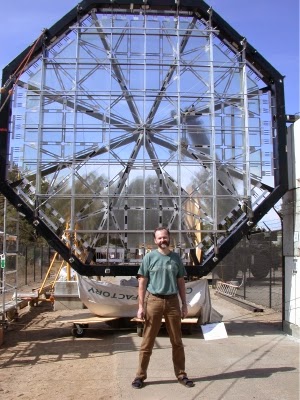This week’s lecture topic, Math + Art, expanded on what I
already knew in terms of science affecting art and also introduced me to how
art can influence science. The lecture video reiterated what I had
previously learned about perspective and the golden ratio in an art history
class, but what I found most interesting was how these scientific notions had
affected film and the media. For example, the TV show Numb3rs plot was based
on the golden ratio, and The DaVinci Code, an incredibly successful book and
movie, would not have been possible without Fibonacci’s number and the
Vitruvian man.
The National Gallery in London
“The Fourth Dimension and Non-Euclidean Geometry in Modern Art:
Conclusion,” explains how intertwined Einstein’s relativity theory is to
modern art and the use of a fourth dimension. Traditionally, I would not have
thought that artists would be so interested in such a complex topic. In
addition, an article on Robert J. Lang’s origami site about his work with the
Eyeglass Telescope proves just how valuable something I considered a hobby,
origami, can be in advancing space technology.
A variety of origami pieces
Partnering with the Department
of Energy, Lang helped them develop a model for a telescope that could fold up
and expand without ruining the lens. He mentions how an origami-based solar
panel was put on a satellite in the 1980s, proving just how long this
collaboration with origami and space has lasted.
Lang with the Eyeglass telescope.
This piece truly changed my
previous view that only science could alter art, not vise versa. Artists are
influenced by science as equally as scientists are influenced by art. Through
this week’s material, I can now see how small the juxtaposition between art and
math is, and moreover, how one would not be able to exist without the other.
REFERENCES
Henderson, Linda D. "The Fourth Dimension and Non-Euclidean Geometry in Modern Art: Conclusion." Leonardo 17.3 (1984): 205-210. JSTOR. Web. 10 Apr. 2015.
Hyde, Rob. Photograph of the Eyeglass Prototype on its Test Range at Lawrence Livermore National Laboratory, Livermore, California. Digital image. Eyeglass Telescope. Robert J. Lang Origami, n.d. Web.
Lang, Robert J. "Eyeglass Telescope." Robert J. Lang Origami. N.p., n.d. Web.
Origami. Digital image. Origami. Japanese Canadian Cultural Centre, n.d. Web.
TJ Blackwell. National Gallery in London. Digital Image. The Golden Mean and Aesthetics. Phys.org, 3 Dec. 2013. Web.



I thought the example of Robert J. Lang's "eyeglass telescope" was really interesting. I can see art influencing the exterior in terms of print, texture, etc. However, using art/ origami for the practicality of design is not something I associated with it previously. I looked up the article on this story and it was great to see the thought process of how they got there. This makes me realize that our own hobbies and interests can influence problem solving in all subjects.. especially in creative ways!
ReplyDelete